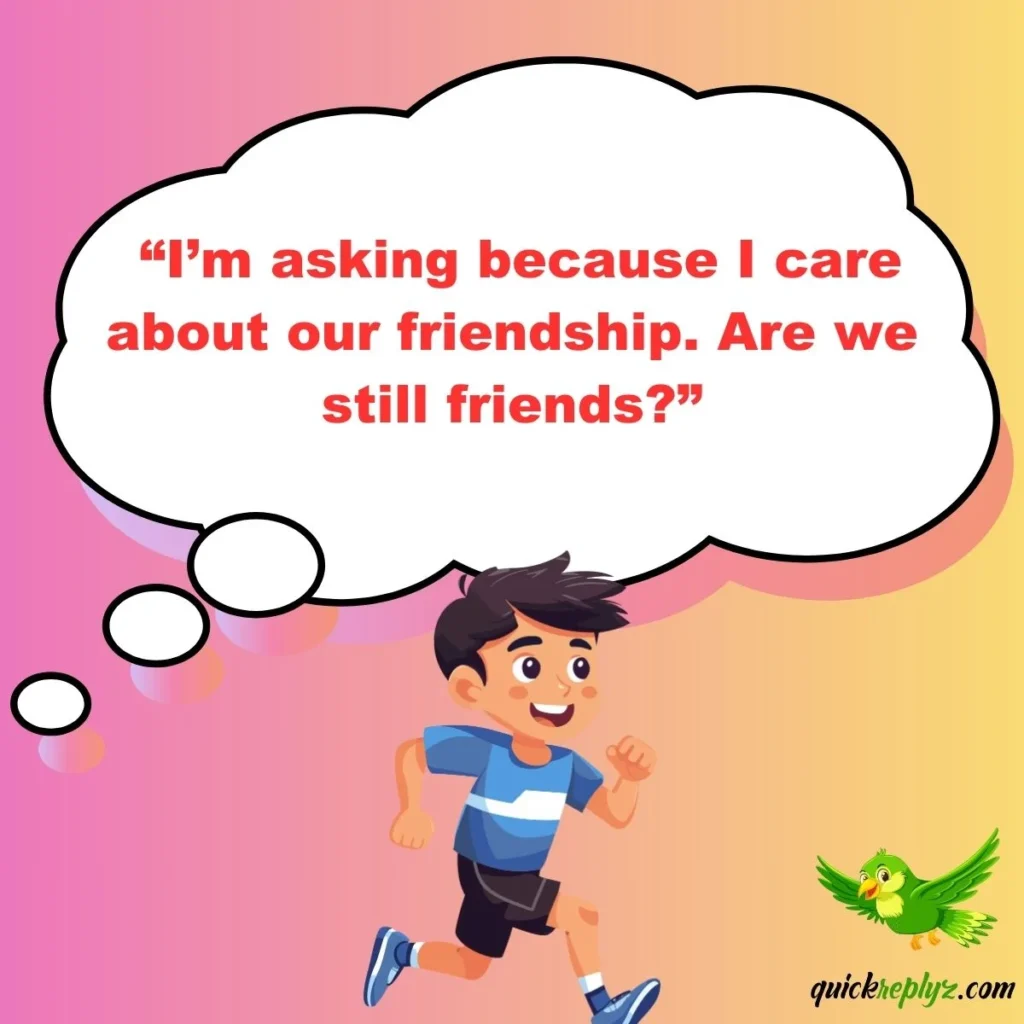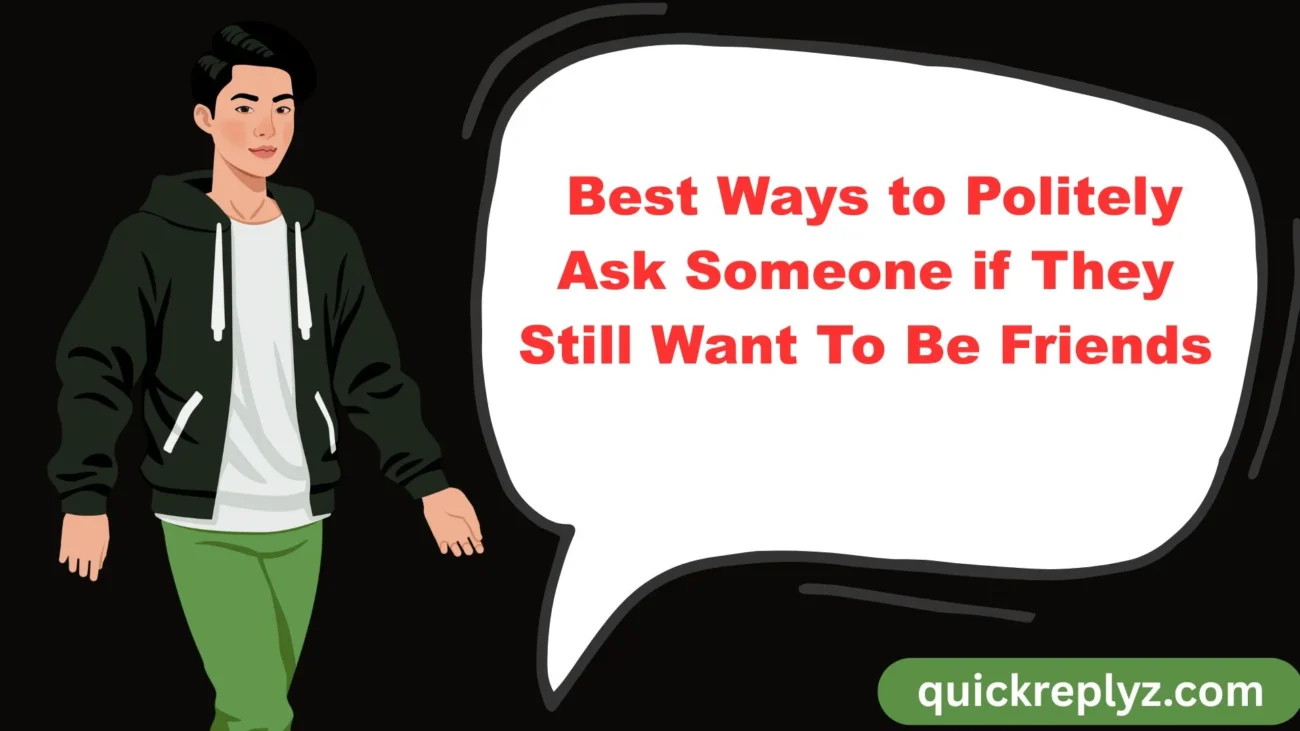Friendships are precious, but sometimes we feel a distance growing between us and someone we care about. Knowing how to politely ask someone if they still want to be friends can be tricky, yet it’s essential for clarity and emotional wellbeing. Approaching this topic with respect, honesty, and kindness ensures that both parties feel understood and valued. In this article, we explore 30 practical ways to navigate this sensitive conversation, giving you confidence, tact, and empathy while maintaining healthy boundaries.
Another or Professional Way to SaysThey Still Want To Be Friends
- “I’ve noticed we haven’t talked much lately. Are we still on the same page as friends?”
- “I value our friendship and wanted to check if you feel the same.”
- “I feel we’ve drifted a bit. Do you still want to maintain our friendship?”
- “Can we talk about where we stand as friends?”
- “I want to make sure we’re on the same wavelength as friends.”
- “I’ve been feeling uncertain about our friendship and wanted your thoughts.”
- “Are we still close? I want to be sure we’re on the same page.”
- “I value you as a friend, but I feel some distance. How do you feel?”
- “I’d love to know if our friendship still matters to you.”
- “It seems we’ve grown apart. Are you still interested in staying friends?”
- “I want to understand how you feel about our friendship.”
- “Can we revisit our friendship and see where we stand?”
- “I miss our connection. Do you want to continue being friends?”
- “I feel we’ve been distant lately. Do you want to keep our friendship alive?”
- “I want our friendship to stay healthy. Are we okay?”
- “I hope I’m not overstepping, but I want to know where we stand.”
- “It’s important to me that we’re both happy as friends. What do you think?”
- “I’d like to clarify our friendship to avoid misunderstandings.”
- “I want to ensure we both feel valued as friends.”
- “I’m asking because I care about our friendship. Are we still friends?”
- “I’d love to continue our friendship if you feel the same.”
- “I want to make sure our friendship is meaningful for both of us.”
- “I feel uncertain about our friendship. Can we talk?”
- “Are we still on the same page as friends?”
- “I want to hear your thoughts about our friendship.”
- “I care about our friendship. Are we still connected?”
- “I feel we might need to talk about our friendship.”
- “I want to make sure we’re both comfortable in this friendship.”
- “It matters to me to know if we’re still friends.”
- “I hope our friendship continues. How do you feel?”
1. “I’ve noticed we haven’t talked much lately. Are we still on the same page as friends?”
Sometimes life gets busy, and friendships naturally evolve. This message opens the conversation gently without blame, showing you care.
Example: “Hey, I realize we haven’t caught up in weeks. Are we still good as friends?”
Best Use: Texting or messaging when distance is noticeable, keeping the tone soft and non-confrontational.
2. “I value our friendship and wanted to check if you feel the same.”
Direct yet kind, this approach reassures the other person of your appreciation while seeking honesty.
Example: “I really enjoy our friendship. Do you feel the same way?”
Best Use: Face-to-face or video calls, for expressing sincerity clearly.
3. “I feel we’ve drifted a bit. Do you still want to maintain our friendship?”
Acknowledging the change without judgment shows emotional awareness.
Example: “It feels like we haven’t been close lately. Do you still want to stay friends?”
Best Use: Best in written messages when distance is more emotional than physical.
4. “Can we talk about where we stand as friends?”
Simple and honest, it opens a safe space for dialogue.
Example: “Hey, can we chat about our friendship and how we feel about it?”
Best Use: Use when scheduling a conversation, allowing the other person to prepare mentally.
5. “I want to make sure we’re on the same wavelength as friends.”

Focuses on mutual understanding rather than blame.
Example: “I’d love to know if we’re still connected as friends.”
Best Use: Face-to-face or voice messages to convey genuine curiosity.
6. “I’ve been feeling uncertain about our friendship and wanted your thoughts.”
Opens communication with vulnerability, encouraging honesty.
Example: “Lately, I feel unsure about us. How do you see our friendship?”
Best Use: Works well in private, one-on-one conversations.
7. “Are we still close? I want to be sure we’re on the same page.”
Direct and friendly, this phrase seeks clarity without pressure.
Example: “I hope we’re still close. What do you think?”
Best Use: Casual text message to gently check in.
8. “I value you as a friend, but I feel some distance. How do you feel?”
Shows respect and invites the other person to share their perspective.
Example: “I feel some distance between us. Do you feel the same?”
Best Use: Ideal for meaningful discussions where emotions need acknowledgment.
9. “I’d love to know if our friendship still matters to you.”
Direct and heartfelt, this question signals your care without guilt.
Example: “Does our friendship still mean as much to you as it does to me?”
Best Use: In written form, when clarity is your main goal.
10. “It seems we’ve grown apart. Are you still interested in staying friends?”
Acknowledges reality gently and seeks honesty.
Example: “I’ve noticed some distance between us. Do you still want to be friends?”
Best Use: Face-to-face or over a call, emphasizing empathy.
11. “I want to understand how you feel about our friendship.”
Invites open dialogue and emotional transparency.
Example: “I’d like to hear how you feel about our friendship right now.”
Best Use: Video or voice conversation for authentic interaction.
12. “Can we revisit our friendship and see where we stand?”
Encourages reflection and joint assessment.
Example: “Let’s take a moment to talk about our friendship. Are we still aligned?”
Best Use: When friendship dynamics have changed over time.
13. “I miss our connection. Do you want to continue being friends?”
Focuses on emotional bond and mutual desire.
Example: “I miss the way we used to connect. Do you want to keep our friendship going?”
Best Use: Text or call when you want to express longing without pressure.
14. “I feel we’ve been distant lately. Do you want to keep our friendship alive?”
Direct but compassionate, showing investment in the relationship.
Example: “We haven’t talked much. Is our friendship still important to you?”
Best Use: Best for sensitive situations where distance is noticeable.
15. “I want our friendship to stay healthy. Are we okay?”
Shows concern for the quality and health of the relationship.
Example: “I care about our friendship. Are we still okay?”
Best Use: Face-to-face or messaging for reassurance and mutual care.
16. “I hope I’m not overstepping, but I want to know where we stand.”
Balances caution with honesty.
Example: “I don’t want to overstep, but can we talk about our friendship?”
Best Use: Email or text when sensitivity is needed.
17. “It’s important to me that we’re both happy as friends. What do you think?”
Shows care for mutual satisfaction in the friendship.
Example: “I want us both to be happy in our friendship. How do you feel?”
Best Use: One-on-one talks where feelings need discussion.
18. “I’d like to clarify our friendship to avoid misunderstandings.”
Practical and considerate, focusing on clarity.
Example: “Can we clarify how we feel about our friendship?”
Best Use: Written or verbal communication to avoid future confusion.
19. “I want to ensure we both feel valued as friends.”
Highlights respect and equality in friendship.
Example: “Do you feel our friendship is still valuable to you?”
Best Use: Face-to-face, especially after noticeable distance.
20. “I’m asking because I care about our friendship. Are we still friends?”

Shows motivation and transparency.
Example: “I care about us. Are we still good friends?”
Best Use: Text, call, or in-person check-ins for direct honesty.
21. “I’d love to continue our friendship if you feel the same.”
Gentle invitation to mutual agreement.
Example: “I want to keep being friends if you do too. What do you think?”
Best Use: Messaging for casual yet meaningful dialogue.
22. “I want to make sure our friendship is meaningful for both of us.”
Focuses on reciprocity and significance.
Example: “Are we both getting what we need from our friendship?”
Best Use: Deep discussions to ensure balance.
23. “I feel uncertain about our friendship. Can we talk?”
Opens the door for honest conversation.
Example: “I’m not sure how we’re doing. Can we talk about it?”
Best Use: When you sense confusion or tension.
24. “Are we still on the same page as friends?”
Concise and direct, suitable for casual check-ins.
Example: “Just checking, are we still on the same page as friends?”
Best Use: Quick text messages for simplicity.
25. “I want to hear your thoughts about our friendship.”
Invites participation and shared perspective.
Example: “I’d like to know how you see our friendship.”
Best Use: One-on-one conversations or calls for honesty.
Also Read This : 30 Funny Answers to “What’s Up?”
26. “I care about our friendship. Are we still connected?”
Shows care while seeking clarity.
Example: “Do you still feel connected as friends? I care about this.”
Best Use: Messaging when emotional honesty is needed.
27. “I feel we might need to talk about our friendship.”
Acknowledges potential issues tactfully.
Example: “I think it’s time we discuss our friendship. Are you open to it?”
Best Use: Face-to-face for delicate situations.
28. “I want to make sure we’re both comfortable in this friendship.”
Focuses on mutual comfort and consent.
Example: “Are we both comfortable with our friendship as it is?” Best Use: Suitable for friendships with recent misunderstandings.
29. “It matters to me to know if we’re still friends.”
Clear, concise, and heartfelt.
Example: “I really want to know if we’re still friends. What do you think?”
Best Use: Direct messages or casual conversations.
30. “I hope our friendship continues. How do you feel?”
Ending on positivity and openness, showing hope for the future.
Example: “I hope we can stay friends. How do you feel about it?”
Best Use: Wrap-up conversation after discussing uncertainties.
Conclusion
Asking someone if they still want to be friends can feel intimidating, but approaching it with honesty, respect, and empathy makes a huge difference. Using the right words allows both parties to share their feelings safely, fostering clarity and emotional health. The 30 strategies above offer practical, gentle ways to navigate this conversation without causing conflict or misunderstanding. Remember, friendships are reciprocal, and sometimes even polite conversations lead to stronger bonds or healthier boundaries.
FAQs
Q1: How do I know which approach to use?
A1: Choose based on your relationship dynamics—use casual phrasing for light friendships, and honest, direct messages for deeper bonds.
Q2: Is it okay to ask this via text?
A2: Yes, but sensitive conversations may be better face-to-face or via call to avoid misinterpretation.
Q3: What if they don’t respond?
A3: Give them time and space. Their response, or lack thereof, is a sign to evaluate the friendship.
Q4: Can I use humor to ask this?
A4: Light humor is fine if it suits your friendship style, but avoid sarcasm that could cause misunderstanding.
Q5: How can I stay polite even if the friendship ends?
A5: Thank them for the good times, express understanding, and maintain dignity in your response.

